CO’s Four Favorite Projects Under Construction in New York
By Vicki Speed March 9, 2016 2:00 pm
reprints
Ever since William and Arthur Zeckendorf hired Robert A.M. Stern to design 15 Central Park West, which mimicked the Rosario Candela buildings of yore, developers realized that there was great hunger for a handsome, well-designed building. And big bucks to be made if done successfully.
They’ve since put considerable investment in beautifying the designs of large commercial, residential and mixed-use projects around the city. And the last few years have proven a boon for this kind of construction with Downtown marvels, like the Oculus and One World Trade Center, opening to the public. The following four projects currently under construction (or just finished) are unique in terms of complexity, such as VIA 57West and 56 Leonard and adaptive reuse and renovation, such as the Woolworth Building Tower and the Victoria Theater.
A Woolworthy Cause
A little over three years ago, Kenneth Horn, the president of Alchemy Properties, and Alexander Saltzman, a partner at Alchemy, agreed to tour the top 30 floors of the iconic Woolworth Building at 233 Broadway with admittedly more curiosity than commitment. Their perspective took a dramatic shift when they took the first steps into a grand space that seemed to ooze character and class from a bygone era.
“I was overwhelmed,” Mr. Horn said of that time. “We knew very quickly it was the right project for us. From a business perspective, we had a gem, a large amount of vacant space in a historic building in a prime location that could be converted into top-flight residential space where none really exists. From a personal standpoint, we understood we also had a great responsibility.”
First constructed in 1913, the Woolworth Building is a reminder of a different time. Frank Woolworth had the building constructed as a place from which to run the F. W. Woolworth Company at the time. He also rented space in the building to other companies, such as Columbia Records and even a dentist, who purportedly leased a part of the tower office space some 50-60 years ago.
Until Messrs. Horn and Saltzman bought the space for $68 million in July 2012, the entire tower had been vacant for 10 years. Today, it’s undergoing a renovation that would make the original architect, Cass Gilbert, and Frank Woolworth proud and is certainly a signature project for Alchemy.
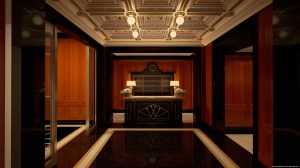
The first 18 months after Alchemy purchased the tower was less about designing beautiful space and more about coordination.
“Since the building is designated as a landmark, we work closely with the New York Landmarks Preservation Commission’s historical consultants to retain as much of the structural history as possible,” Mr. Horn said. “Also, at the time we purchased the space, the tower pinnacle was not zoned for residential use because the windows weren’t big enough. We also needed to bring the interior structure up to the current building codes.”
Today, with about 18 months of construction remaining, the Alchemy team has expedited an impressive transformation with the vision of architect Thierry W. Despont. Mr. Despont’s design successfully marries the new and the old, the historical feel with contemporary comforts within the interior’s pre-war proportions that include ceiling heights of up to 17 feet. Details will include custom Woolworth Building-monogrammed door hardware and kitchen centerpieces with spectacular views of the city.
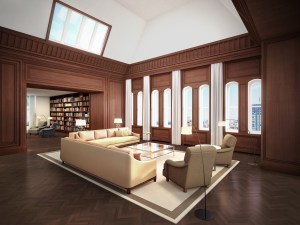
From the restoration of the Woolworth pool using Gilbert’s drawings to the decorative frames around the elevator entrances and the W tiles from Frank Woolworth’s office, the building’s original character is embedded in every aspect of the renovation.
Mr. Horn said his favorite architectural element is the original coffered ceiling tiles from Woolworth’s office. The ornate tiles are 40-inch square plaster tiles painted in six different colors that weigh about 70 pounds each. Mr. Horn noted, “We had each one of them painstakingly restored for use in the lobby. It’s so personal to Woolworth, the man, and the closest we get to the history of the building that is an architectural masterpiece.”
Each of the units will be grand in scale and commensurate with what the new architect believes Gilbert and Woolworth would have envisioned if developing a residential space.
There will be a total of 34 luxury one-of-a-kind half-floor and full-floor residences that start on the 29th floor and an over 9,000-square-foot, five-level pinnacle penthouse in the tower. The residences will have one, two, three and four bedrooms. The square footage ranges from 1,300 square feet for a one bedroom to over 6,000 square feet for a four bedroom. Two of the residences, located on the 49th floor will have private terraces. For the interior design, Mr. Despont stayed true to the lines of each floor and each unit. Prices range from $4.6 million for a one bedroom to $26.4 million for a four bedroom.
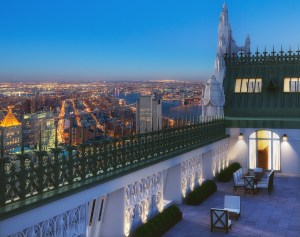
The 9,000-square-foot pinnacle penthouse includes an outdoor observatory, a two-floor living room with a fireplace and an elevator. The ceiling heights range from just under 10 feet to 17 feet, and the windows are five feet by eight feet. The windows are framed on the outside in terra cotta, which will give the residents a reverse picture frame effect. Messrs. Horn and Salzmann worked closely with the city’s Landmarks Preservation Commission to repair and replace the terra cotta façade and to construct the terraces.
The renovation is on track for completion by the end of 2017.
“The Woolworth project is a very different project from any of our previous works—or likely anything the firm takes on in the future,” Mr. Horn said. “We’ve never done anything that compares to the scope of approval and scrutiny required for it. It’s truly a signature project in our portfolio that is important to us from a historical and cultural perspective.”
Kind of a BIG Deal
Drivers along the West Side Highway have noticed something a little unusual coming out of the ground as they hit West 57th Street: an enormous pyramid.
Unveiled last week for residential and commercial use, VIA 57West, at 625 West 57th Street, is as impressive inside and outside as anticipated when the concept was first proposed in 2010.
The 32-story, tapered tetrahedron-shaped structure located along 12th Avenue along the Hudson River waterfront optimizes the number of units with views of the Hudson River while preserving Durst Organization’s adjacent Helena 57West tower’s line of site.
It’s been a long time coming considering the Durst Organization has held the lease on the property since 1999. Jordan Barowitz, the spokesman for Durst Organization, recalls all of the concepts that have been considered for the site. “We’ve considered a data center, an office building, a school, a hotel and a medical services building as well as two rezoning efforts in the last 16 years,” Mr. Barowitz said. “We realized that residential would work best because of its location; and we needed an iconic structure.”
Remarkably, the partnership to create the unique structure came about from a less-than-cordial meeting. Douglas Durst, the chairman of Durst Organization, had completed a presentation about sustainability in Copenhagen when he was approached by Danish architect Bjarke Ingels. Mr. Ingels asked him why his buildings look like buildings.

Impressed with the brashness of Mr. Ingels, Mr. Durst toured the architect’s studio in Denmark in 2010 and was impressed with his unconventional approach to design.
Subsequently, Mr. Durst hired Mr. Ingels to develop something special for the VIA 57West site. The architect envisioned a structure that would maximize light in all of the apartments.
The structure rises to 467 feet at its peak and features 709 rental residences (with 178 different floor plans), 45,000 square feet of retail space at ground level, offices and community facilities on the second level as well as underground parking and a signature 22,000-square-foot interior courtyard that opens onto the Hudson River, called the VIA Garden. The holistic garden incorporates 43 trees, 50 native plant species, outdoor seating and barbecue grills.
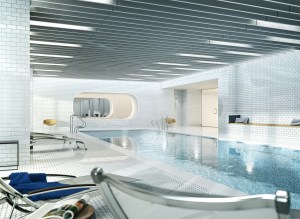
Below the 34th floor, each level incorporates a flat plate concrete slab with embedded transfer girders within the slab to accommodate the façade setbacks. The top 10 floors are comprised of a steel structure, which also provides mechanical, window washing and façade support. Floodwalls are incorporated into the west side of the structure as 100-year-flood prevention. The curtain wall is immensely complex.
Gavin Schiraldo, a project executive at Hunter Roberts Construction Group, the general contractor on the project, noted, “The sloped wall incorporates approximately 1,200 different panels with an x-y-z geometry.”
Throughout construction, the Hunter Roberts Construction Group relied on 3D design and surveying technology to ensure the optimal and accurate placement of all structural elements.
The $600 million VIA 57West construction will be finished by summer 2016. Residential leasing began March 1. On average, rents are $2,770 for a studio, $3,880 for one bedroom, $6,500 for two bedrooms, $11,000 for three bedrooms and $16,500 for four bedrooms. In November 2015, the Livanos Restaurant Group became the first operator to lease space in the structure.
Victoria’s Makeover
The $164 million renovation and development of Victoria Theater is a welcome makeover to one of Harlem’s most culturally and historically significant structures.
The theater, at 233 West 125th Street between Frederick Douglass and Adam Clayton Powell boulevards, was originally designed by Thomas Lamb, a Scottish-born architect who specialized in theaters and cinemas, such as the Boston Opera House. He built the Victoria Theater in 1917 as part of the Loews nationwide theater chain.
Unfortunately, after years of failed businesses, the historic theater fell into disrepair, and much of its old-world elegance was lost behind layers of peeling sheetrock, old flooring and chipped paint. In 2008, Danforth Development Partners and Exact Capital put together an adaptive reuse plan to preserve the theater, add a 5,000-square-foot ballroom and 25,000 square feet of dedicated space for local cultural institutions, and add a 26-story Renaissance Hotel by Marriott—a 206-unit apartment tower that includes affordable housing, as well as parking and retail.
The $164 million project, which includes $47 million in public funding and is targeting LEED Silver certification, is on track for completion in 2017. The Lam Group is developing the site and Aufgang Architects is responsible for the design.
Demolition, renovation and new construction at the site began in mid-2015. As part of the mixed-use plan, the Victoria Theater’s three-story structure will be restored, including the ornate lobby, terra cotta façade, marquee and signage.
“Like the nearby Corn Exchange Bank Building and the Brillo Factory renovation in Brooklyn, there is considerable push and pull in the design phase of a project because of the theater’s historic status,” said Ariel Aufgang, the principal of Aufgang Architects. “Our challenge was to design a tower that doesn’t loom over and overshadow the historic theater façade.”
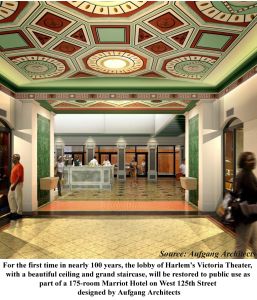
Mr. Aufgang and his team believe they’ve accomplished this by setting the tower 30 feet back from the exterior, helping give the theater a freestanding feel and appealing perspective from street level.
“For the towers, we went with very modern sheer glass façade without historic replication so we didn’t distract from the terra cotta theater façade,” he said.
Construction crews are now selectively pulling apart the old flooring, walls and elements in the theater lobby, taking special care to evaluate the construction elements below. For example, during the demolition, crews found the original terrazzo floor in the lobby entrance. The marble staircase to the balcony was fully intact but covered in flooring and carpet. A bonus, the demolition team also found a few of the original architectural design sheets in the basement that showed the original lobby and second-floor overlook. The walls were scored and textured to look like marble. The entire lobby will be preserved and restored, including floors, ceilings and walls that include natural stone and painted plaster materials. The original lighting fixtures will be replicated. Some of the frames that surrounded mirrors were covered in layers of sheetrock and will be restored and preserved as will the seven-foot decorative green mosaic water fountains.
Specialty contractors have unearthed layers of paint in the lobby to find the original colors, which will be duplicated.
Important commercially, architecturally and culturally, 125th Street is the area’s most important thoroughfare that visually underscores Harlem’s music and arts tradition.
“The architects and builders in the early 20th century paid a tremendous amount of attention to detail. Many of the buildings at the time could be considered works of art,” Mr. Aufgang said. “That’s why the interior restoration of the Victoria Theater stays true to the original design.”
To date, the asbestos removal process has been completed inside the theater, and crews are now peeling layers of sheetrock and carpeting from the interior. The Victoria Theater project is on track for completion in 2017.
Glass Action
The nearly complete 60-story 56 Leonard Street luxury condominium tower forever changes the look and feel of Lower Manhattan’s Tribeca. The edgy, modern structure incorporates 145 innovative residences, including 10 glass penthouses at the top.
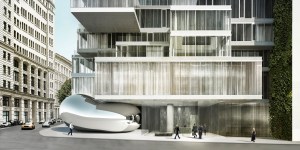
The development of the structure goes back nearly a decade. The Alexico Group first partnered with Goldman Sachs and Dune Real Estate Partners to buy the land for $140 million in 2006 and begin constructing the structure to the specifications first imagined by Swiss firm Herzog & de Meuron. The firm is best known for its design of the Bird’s Nest stadium in Beijing and the Tate Modern museum in London. The developers noted that the architectural firm’s principals, Jacques Herzog and Pierre de Meuron, spent close to a year studying the Tribeca site to create something unique with advantageous views. Instead of hiding the living and working space behind concrete, glass and steel, the Swiss architects wanted to “uncover” the life that hides behind New York City’s typical high-rise buildings to reflect the inner workings of a building.
At the end of that year, they envisioned an unconventional 830-foot-tall tower with cascading asymmetrical floor slabs and stacked glass façade with random cantilevered glass balconies and terraces, which look like a glass Jenga tower.
Unfortunately, the recession put the developers’ plans on hold until 2011. In 2013, Dune and Goldman Sachs partnered with Hines to co-develop the site and construction on the project resumed.

The general contractor, Lend Lease, is nearly done with construction. Forming the 300 cantilevered balconies on the cascading slabs proved particularly challenging for the contractor and its concrete subcontractor, Sorbara Construction Corp. The floor slabs were supported during construction with custom formwork girders that have a high load-bearing capacity and rigidity for the slabs and platforms and aluminum shores.
The base of the unique structure includes specially commissioned work by sculptor Anish Kapoor.
The ninth and 10th floors have a sky estuary with a 75-foot infinity edge pool, outdoor sun deck, indoor/outdoor theater, library lounge and fitness center, yoga studio, steam room and sauna.
Ten penthouses occupy the top 10 stories. Each has up to 200 feet of continuous window walls that reveal breathtaking views in each direction of the city, rivers and further and 14-foot ceilings. The full-floor penthouses have around 5,500 square feet of interior space and 745 square feet of outdoor space while the half-floor penthouses have around 3,700 interior square feet with a smaller outdoor terrace, all custom-designed by Herzog & de Meuron.
According to the developer, the building’s exposed concrete is complemented by a basic palette of champagne window-walls, satin-etched glass, natural solid oak woods, travertine, Thassos marble, polished metals, black granite, high-gloss black lacquer accents and finished concrete columns that architecturally enhance the penthouse living spaces.
Construction at 56 Leonard Street is nearly complete and residents are expected to begin moving in in April 2016. Currently, there are only two apartments out of 145 units remaining for sale. (Prices for units in contract range from around $3 million for a one-bedroom, up to $47 million for a four-bedroom, according to Streeteasy.)


